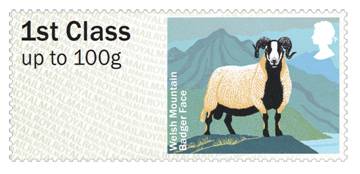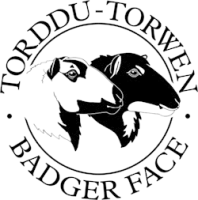History of the breed
The Badger Face Welsh Mountain is a sheep with a long history. Sheep with the now familiar “badger” markings have been seen for as long as sheep have wandered the mountains and hills of Wales.
The breed comes in two distinct colours; Torddu and Torwen. Torddu (pronounced Torthee) means black belly and is mainly white with a distinctive black underbelly and eye stripes, while the Torwen (white belly) shows the reverse colouring with smaller eye stripes. The Torddu is about three times more numerous than the Torwen and is known as the Badger Face.
It is difficult to identify the origin of the breed with any certainty. The Torwen colour pattern shows a strong similiarity with the Soay and Mouflon and there is reason to believe that at one time a high proportion of Welsh Mountain sheep were coloured, but requirements of the cloth trade in the Middle Ages caused flock masters to select more and more for white. The old alternative name for Torddu - Defaid Idloes - indicates an even earlier origin as St Idloes was a 7th century figure.
In 1922-23 extensive breeding experiments were carried out by Dr Frazer Roberts (geneticist) at the University College of North Wales, Bangor. The society holds a copy or the results of these trials.
It is known that many breeds round the world carry the badger face gene. Where both parents carry this gene, lambs with the now well known badger face markings will be seen. In pure Welsh Mountain flocks, a handful of badger marked lambs are seen most years. The introduction of a new ram can make a difference; if the ram, although a pedigree white Welsh mountain, carries the badger face gene then the 1 or 2% of ewes that have the gene will produce badger face marked lambs.
Badger Face are relatively small - a typical ewe weighs 40kg-50 kg. The breed produces exceptionally high quality meat with fine texture and excellent flavour.
Torwen ram
A popular breed
The Badger Face has had more entries than any other native breed in the Royal Welsh Show for the last ten years. Usually about 200 sheep are on show and are always judged on the first day. A large crowd gathers to watch the judge sort out the best in class ( a huge task in some classes as entries of 30+ are often on show). Nearly every show in Wales has classes for the Badger Face and they can be seen in other areas – usually placed in “any other breed” sections.
Prolific, hardy and fast-growing
They are more prolific than the Welsh Mountain and in the right (lowland) conditions can achieve 200% lambs. 160% is common in upland conditions with a high survival rate which is helped by the lamb’s determination to get on its feet, often in a few seconds.
Growth rates of 200gm per day are easily achievable in purebred sheep fed on grass alone, with higher rates reported in crosses.
Performance statistics:
Lambing % | Ranging from 100 to 200%. Farms up to 1000 ft have had 170%. The average from all members reports was 150% |
Birth Weight | 6 to 11 lbs. (2.7 to 5 kg) Many comment that the lambs are strong, want to live and are quickly up and sucking |
Lambing Date | Most will lamb from early March through to early May. January lambs are seen in some areas where early fat lambs are required |
Ewe Breeding life | Many members report ewes up to 10 years old still producing good crops. One member kept a Torddu ewe for 14 years which produced 24 lambs in12 pregnancies including one set of triplets |
Ewes per ram | Often 30 to 35 but up to 75 is reported. Badger rams are known to be active. Ram lambs have size & vigour to work in their first year |
Other Comments | Quiet, friendly, choice of colours, good looking sheep, high stocking rate, easy lambing, low vet costs, popular in the show ring,brilliant taste- try some! |
Growth rates: | A kilo every 5 days is easy to achieve in pedigrees. When crossed with continental rams (Texel, Charollais, Blue Texel & others) a kilo every three days is common |
Fame for the Torddu

The Badger Face Torddu represented as part of the Royal Mail British Farm Animals stamp collection issued February 2012. These are still available to purchase.
Breed standard updated
The definition of the breed standard has been updated and revised. You can find details on the Breed Standard page or download a .pdf version here.
